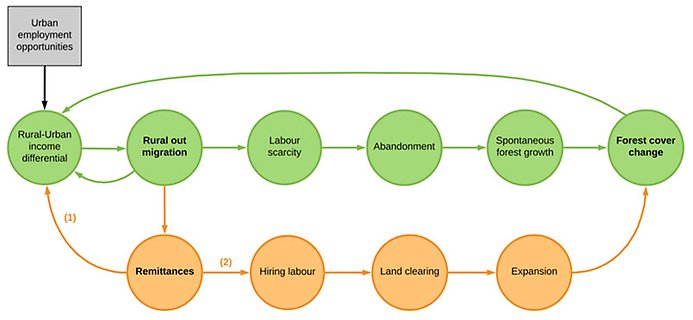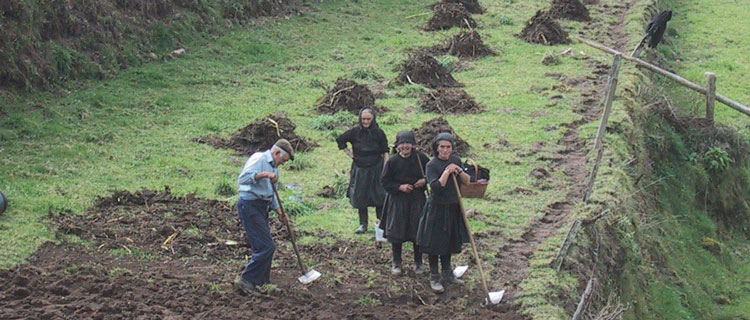Bildtext får vara max två rader text. Hela texten ska högerjusteras om den bara ska innehålla fotobyline! Photo: B. Christensen/Azote
TELECONNECTIONS
Money for farming or forests?
Money sent home by migrants can prevent undesired farmland abandonment, as well as the promise of extensive forest regrowth
- Remittances, the money that migrants send back home, are an important rural-urban “teleconnection” that can reshape rural livelihoods and land use decisions
- The model developed in the study links migration, remittances, farmland abandonment, and forest growth
- Two uses of remittances, household consumption and hiring agricultural labour, were shown to influence the system in different ways, preventing farmland abandonment and forest regrowth
There are more than a billion migrants in the world today. Most of them move from the countryside to cities to find employment. The resulting loss of labour in agriculture has historically tended to concentrate farming to the most productive pieces of land while allowing forests to regrow in other areas.
A century ago, this development was common in Europe and the United States, but today’s technologies of communication and transport make it possible for migrants to remain connected with their homes. This has important implications for land use and forests.
“Contemporary forest transitions have to be understood in the context of globalisation and teleconnections,” concludes a group of researchers in a study published in the journal Environmental Research Letter.
‘Teleconnection’ is a term widely used in atmospheric science, but it has also been used to describe how social and ecological impacts do not necessarily unfold in the same place where they originate, but can sometimes result from long-distance relationships. In this case, centre researchers Daniel Ospina, Garry Peterson and Anne-Sophie Crépin have studied how remittances, the money that migrants send back home, can reshape rural livelihoods and land use decisions of importance for local forest ecosystems.
Three times official development assistance
In 2017, international remittances to developing countries reached $466 billion, three times the size of official development assistance. Internal remittances are believed to be at least as large as the international flows, but reaching more and poorer people.
Ospina and his colleagues built their analysis of remittances on a model that links migration, farmland abandonment and forest regrowth. They extended it to incorporate remittance flows, which could be used in two alternative ways by rural households. The two uses of remittances were hiring agricultural labour or supplementing household consumption, which were also related to increasing differences between rural and urban incomes.
“The dynamic forest ecology component we introduced meant that we could better assess the effects of migration and remittances on forest regrowth,” explains Daniel Ospina.
Whether farmland abandonment and subsequent forest regrowth is desirable, depends on a variety of considerations: Abandonment of marginal farmlands might be the result of people seeking non-agricultural employment that affords them a higher standard of living. However, farmland abandonment can also be the result of emigration under very distressful situations and can lead to undesirable outcomes such as growing urban slums. Similarly, forest regrowth can be desirable as it provides ecosystem services such as carbon sequestration or soil erosion control, but undesirable if it comes at the expense of complex biocultural landscapes.
Consistent with empirical findings
Based on the extended model Ospina and his colleagues found that remittances changed the interaction between migration and forest growth. Simply put, farmers managed to maintain their farmlands instead of abandoning them. While migration to cities can drive a shift from an agricultural to a forested state due to labour scarcity, the researchers’ model shows how remittances can have a countervailing effect through two different mechanisms (see figure below).
Remittances used for household consumption (1) can reduce migration, and when spent on hiring labour (2), remittances can maintain or even increase the area devoted to farming. Both prevent forest regrowth. The effect is stronger when remittances are used for hiring labour. These results are consistent with findings from previous field research that highlights the remarkable persistence of rural livelihoods and landscapes in the face of increasing global connectivity and urbanization.
“With this simple model we show that social-ecological regime shifts offer a useful perspective to study land use transition dynamics and advance land change theory,” the researchers conclude.

Causal mechanisms linking migration and forest cover.
Methodology
After extending and parametrizing the model based on empirically-grounded stylized facts, the researchers analysed the model numerically. This was done through a series of simulation ‘experiments’, assessing changes in the system’s stability in response to increasing urban wages (increasing rural-urban income gap). This changing context represents a common path of economic development characterized by urbanization and growth of the non-agricultural sectors. The main results came from a comparison of three model configurations: no remittances, remittances used for consumption, and remittances used for hiring labour.
Ospina, D., Peterson, G., Crépin, A-S. 2018. Migrant remittances can reduce the potential of local forest transitions - a social-ecological regime shift analysis. Environmental Research Letters, Accepted Manuscript online 14 November 2018. DOI: https://doi.org/10.1088/1748-9326/aaf0ee
Daniel Ospina is a PhD student at the centre, studying how rural landscapes and livelihoods change, in the context of increasing global connectivity and urbanization.
Garry Peterson is professor in environmental sciences. His research combines three themes: abrupt systemic change, how ecological changes impacts people, and using futures thinking to improve navigating surprising social-ecological change.
Anne-Sophie Crépin's researches the interplay between economic incentives, ecosystem regime shifts, policy and human behaviour. She is also deputy director at the Beijer Institute of Ecological Economics.









